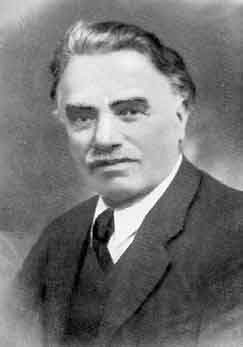.
Luigi Bianchi
Luigi Bianchi (January 18, 1856 – June 6, 1928) was an Italian mathematician. He was born in Parma, Emilia-Romagna, and died in Pisa. He was a leading member of the vigorous geometric school which flourished in Italy during the later years of the 19th century and the early years of the twentieth century.

Luigi Bianchi
Like his friend and colleague Gregorio Ricci-Curbastro, Bianchi studied at the Scuola Normale Superiore in Pisa under Enrico Betti, a leading differential geometer who is today best remembered for his seminal contributions to topology, and Ulisse Dini, a leading expert on function theory. Bianchi was also greatly influenced by the geometrical ideas of Bernhard Riemann and by the work on transformation groups of Sophus Lie and Felix Klein. Bianchi became a professor at the Scuola Normale Superiore in Pisa in 1896, where he spent the remainder of his career. At Pisa, his colleagues included the talented Ricci. In 1890, Bianchi and Dini supervised the dissertation of the noted analyst and geometer Guido Fubini.
In 1898, Bianchi worked out the Bianchi classification of nine possible isometry classes of three-dimensional Lie groups of isometries of a (sufficiently symmetric) Riemannian manifold. As Bianchi knew, this is essentially the same thing as classifying, up to isomorphism, the three-dimensional real Lie algebras. This complements the earlier work of Lie himself, who had earlier classified the complex Lie algebras.
Through the influence of Luther P. Eisenhart and Abraham Haskel Taub, Bianchi's classification later came to play an important role in the development of the theory of general relativity. Bianchi's list of nine isometry classes, which can be regarded as Lie algebras, Lie groups, or as three dimensional homogeneous (possibly nonisotropic) Riemannian manifolds, are now often called collectively the Bianchi groups.
In 1902, Bianchi rediscovered what are now called the Bianchi identities for the Riemann tensor, which play an even more important role in general relativity. (They are essential for understanding the Einstein field equation.) According to Tullio Levi-Civita, these identities had first been discovered by Ricci in about 1880, but Ricci apparently forgot all about the matter, which led to Bianchi's rediscovery!
References
Bianchi, Luigi (1894, 1902, 1909). Lezioni di geometria differenziale (three volumes). Pisa: E. Spoerri.
Bianchi, Luigi (1918). Lezioni sulla teoria dei gruppi continui finiti di trasformazioni. Pisa: E. Spoerri. OCLC 4383253.
Hilton, H. (1929). "Luigi Bianchi". J. London Math. Soc. 4: 79–80. doi:10.1112/jlms/s1-4.1.79.
O'Connor, J. J.; & Robertson, E. F.. "Luigi Bianchi". MacTutor History Archive. Retrieved July 10, 2005.
Luigi Bianchi at the Mathematics Genealogy Project
Further reading
Carruccio, Ettore (1970–80). "Bianchi, Luigi". Dictionary of Scientific Biography. 2. New York: Charles Scribner's Sons. pp. 121. ISBN 0684101149.
External links
Robert T. Jantzen (Villanova University) offers translations of some of Bianchi's papers, plus a biography of Bianchi.
Lezioni di geometria differenziale (3 vol.) PDF copy at Gallica, Bibliothèque Nationale de France
Lezioni sulla teoria dei numeri algebrici
Lezioni sulla teoria delle funzioni di variabile complessa e delle funzioni ellittiche (Images at Cornell)
Lezioni sulla teoria dei gruppi di sostituzioni e delle equazioni algebriche secondo Galois (Images at Cornell)
Vorlesungen über differentialgeometrie (PDF/DjVu at archive.org)
Retrieved from "http://en.wikipedia.org/"
All text is available under the terms of the GNU Free Documentation License


